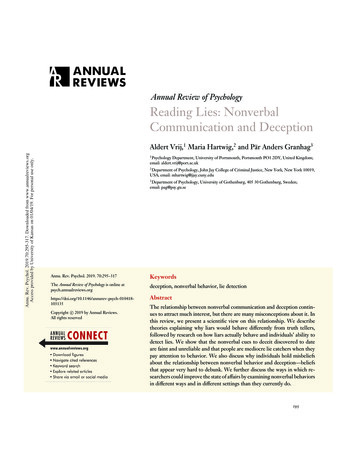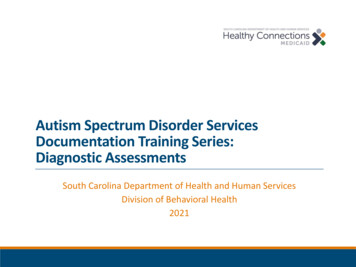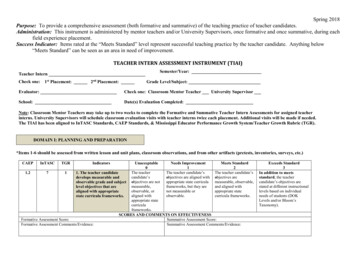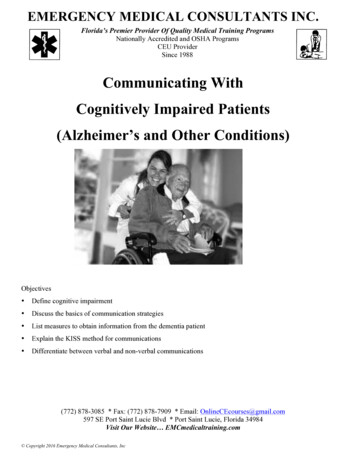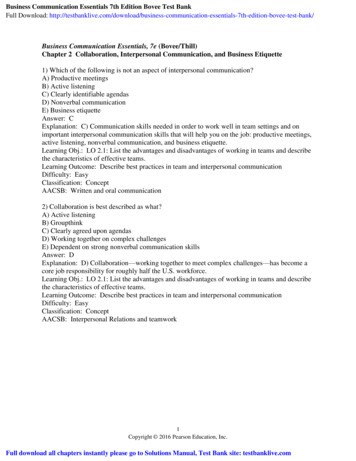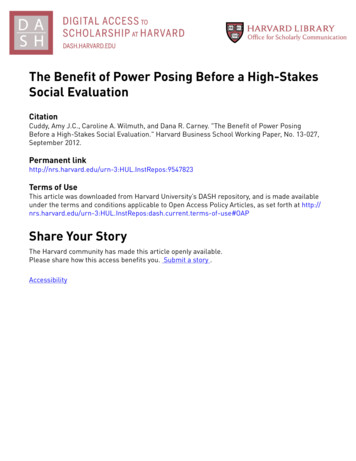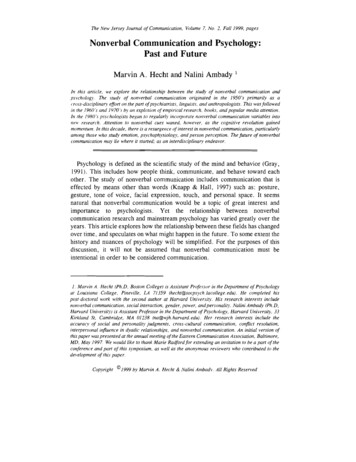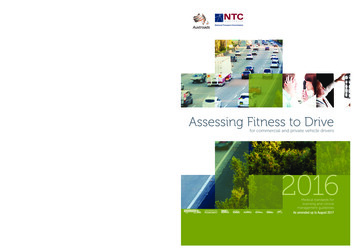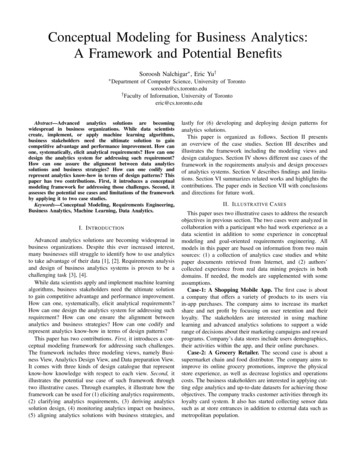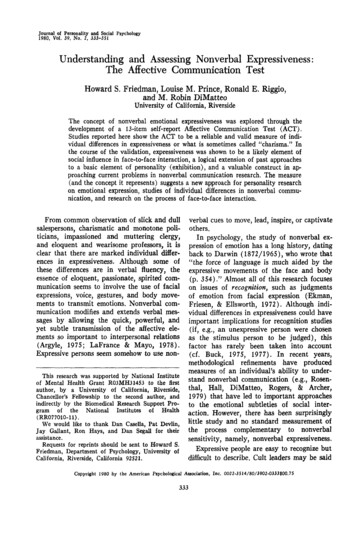
Transcription
Journal of Personality and Social Psychology1980, Vol. 39, No. 2, 333-351Understanding and Assessing Nonverbal Expressiveness:The Affective Communication TestHoward S. Friedman, Louise M. Prince, Ronald E. Riggio,and M. Robin DiMatteoUniversity of California, RiversideThe concept of nonverbal emotional expressiveness was explored through thedevelopment of a 13-item self-report Affective Communication Test (ACT).Studies reported here show the ACT to be a reliable and valid measure of individual differences in expressiveness or what is sometimes called "charisma." Inthe course of the validation, expressiveness was shown to be a likely element ofsocial influence in face-to-face interaction, a logical extension of past approachesto a basic element of personality (exhibition), and a valuable construct in approaching current problems in nonverbal communication research. The measure(and the concept it represents) suggests a new approach for personality researchon emotional expression, studies of individual differences in nonverbal communication, and research on the process of face-to-face interaction.From common observation of slick and dullsalespersons, charismatic and monotone politicians, impassioned and muttering clergy,and eloquent and wearisome professors, it isclear that there are marked individual differences in expressiveness. Although some ofthese differences are in verbal fluency, theessence of eloquent, passionate, spirited communication seems to involve the use of facialexpressions, voice, gestures, and body movements to transmit emotions. Nonverbal communication modifies and extends verbal messages by allowing the quick, powerful, andyet subtle transmission of the affective elements so important to interpersonal relations(Argyle, 1975; LaFrance & Mayo, 1978).Expressive persons seem somehow to use nonThis research was supported by National Instituteof Mental Health Grant R03MH314S3 to the firstauthor, by a University of California, Riverside,Chancellor's Fellowship to the second author, andindirectly by the Biomedical Research Support Program of the National Institutes of Health(RR077010-11).We would like to thank Dan Casella, Pat Devlin,Jay Gallant, Ron Hays, and Dan Segall for theirassistance.Requests for reprints should be sent to Howard S.Friedman, Department of Psychology, University ofCalifornia, Riverside, California 92521.verbal cues to move, lead, inspire, or captivateothers.In psychology, the study of nonverbal expression of emotion has a long history, datingback to Darwin (1872/1965), who wrote that"the force of language is much aided by theexpressive movements of the face and body(p. 354)." Almost all of this research focuseson issues of recognition, such as judgmentsof emotion from facial expression (Ekman,Friesen, & Ellsworth, 1972). Although individual differences in expressiveness could haveimportant implications for recognition studies(if, e.g., an unexpressive person were chosenas the stimulus person to be judged), thisfactor has rarely been taken into account(cf. Buck, 1975, 1977). In recent years,methodological refinements have producedmeasures of an individual's ability to understand nonverbal communication (e.g., Rosenthai, Hall, DiMatteo, Rogers, & Archer,1979) that have led to important approachesto the emotional subtleties of social interaction. However, there has been surprisinglylittle study and no standard measurement ofthe process complementary to nonverbalsensitivity, namely, nonverbal expressiveness.Expressive people are easy to recognize butdifficult to describe. Cult leaders may be saidCopyright 1980 by the American Psychological Association, Inc. 0022-3514/80/3902-0333 00.75333
334FRIEDMAN, PRINCE, RIGGIO, AND DIMATTEOto succeed because of "charisma," and actorsmay be hailed as "spirited," but explanationsusually go no deeper. Expressive people cantransmit emotion and thrill or excite others,but the components and correlates of thisability are not known. This article addressesa number of basic questions concerning affective communication.Part of the difficulty in understanding expressiveness arises from the conflicting frameworks of different researchers. In an attemptto approach the various aspects of expressiveness from one clearly denned perspective, wedeveloped a self-report scale called the Affective Communication Test (ACT). Using thisscale, the concept of expressiveness was explored through a series of validation studies,which constitute the main body of this article.As will be seen, expressiveness is strongly related to dramatic flair and has important implications for various aspects of personalityand social psychology.Research was undertaken in four mainareas. First, pilot testing and reliabilitystudies were conducted to determine whethera short and simple self-report scale was apractical approach to this topic. These effortswere encouraging, and so a full range ofvalidity studies was conducted. Second, therelationships between nonverbal expressiveness and aspects of interpersonal relationswere investigated. It was anticipated thatexpressiveness would be characteristic of people in certain occupations that involve socialinteraction and social influence such as sales,teaching, acting, and politics. Sex differenceswere also examined. Third, the links betweenexpressiveness and traditional approaches topersonality were explored. Following in theresearch traditions concerning personal expressive style and notions of needs or tendencies to excite or thrill others, we searched forpersonality trait counterparts to emotionalexpression. Fourth and finally, the ties between nonverbal expressiveness and nonverbalcommunication skills were studied. That is,videotape studies examined the link betweenexpressiveness and acting (posed emotionalsending).In summary, this article reports the development of a brief paper-and-pencil measureof individual differences in nonverbal expres-siveness. In the course of the validation, anumber of important questions concerning theconcept of expressiveness and its psychologicalimplications were addressed. These includethe social characteristics of expressive people,the personality of expressive people, and therelationship between expressiveness and laboratory research on individual differences innonverbal communication skills.Measuring ExpressivenessAlthough the idea of nonverbal expressiveness is an old one, the topic is not well researched. In part, it seems that the conceptcould not be scientifically studied until basicprogress in understanding nonverbal communication occurred. Only in the past decadehas systematic attention to facial expressions,gestures, and related cues created the conceptual climate prerequisite for a refinedanalysis of expressiveness. However, duringthe past decade, two additional factors havelimited the study of expressiveness. The firstfactor is a certain degree of conceptual ambiguity. Expressiveness has been used to meandifferent things including acting ability, natural sending ability, communication ability,emotionality, femininity, extraversion, responsivity, and empathy. The second factor is theabsence of standard, convenient measuringinstruments. Either ad hoc measures arecreated and definitions change accordingly, orthe concept is ignored entirely. These twoproblems can be addressed through the development of a new measure of expressiveness.On those occasions when nonverbal expressiveness has been studied, it has beengenerally necessary to employ a group of observers to function as judges or receivers. Ifthe judges could recognize the emotion, thesubject was said to be a good sender '(e.g.,Zuckerman, Lipets, Koivumaki, & Rosenthal,1975). The use of judges is costly and unwieldy. Furthermore, judgments obviouslyvary as a function of the judges. The presentresearch therefore attempted to develop apaper-and-pencil measure that is easily administered. Such a measure, if validated,could be usefully employed in a number ofstudies involving nonverbal communication,
NONVERBAL EMOTIONAL EXPRESSIVENESSespecially when the use of judges is notfeasible.Since it is generally believed that nonverbalcues function mostly outside awareness, itseems possible that people may not knowtheir own expressiveness. That is, if we aregenerally not continuously aware of such matters as whether our eyebrows are flashing, wemay have little conscious knowledge ofwhether we are communicating emotion. However, most people receive feedback in socialinteraction and probably can report whetherthey can make a friend feel comfortable orentertained, whether they draw a lot of attention to themselves at parties, and so on. Thus,some self-report scales in this area such asSnyder's (1974) self-monitoring scale withitems like "I have never been good at gameslike charades" (true-false) can reasonably beexpected to show some validity. In fact, suchself-report measures will likely prove useful inthe short run as we attempt to gain a greaterconceptual understanding of individual differences in nonverbal communication. It doesmake sense on a priori grounds to assumesome self-awareness of expressiveness.Pilot TestingOur conception of expressiveness was firstrefined through pilot or preliminary testing.A number of psychologists and psychologystudents generated behavior-related self-reportitems that they thought would measure expressiveness. Items were administered to smallgroups of students, and those that were ambiguous or showed little variance were eliminated. Remaining items were administered to32 students, and item intercorrelations werecomputed. A sample item was "The tempo ofmy voice remains the same, even when I amexcited."As a preliminary validity check, a shortscale was constructed of items that led to highinternal consistency and test-retest reliability,and the scores were compared to ratings ofthe subjects' expressiveness given by theirteaching assistants; the correlations were encouraging. As desired, scores were also foundto be related to the Exhibition scale of Jackson's (1974) Personality Research Form(PRF) (described later). Encouraged that335Table 1The Affective Communication Test"Self-Description Questionnaire1. When I hear good dance music, I can hardlykeep still.2. My laugh is soft and subdued.3. I can easily express emotion over the telephone.4. I often touch friends during conversations.5. I dislike being watched by a large group ofpeople.6. I usually have a neutral facial expression.7. People tell me that I would make a good actoror actress.8. I like to remain unnoticed in a crowd.9. I am shy among strangers.10. I am able to give a seductive glance if I want to.11. I am terrible at pantomime as in games likecharades.12. At small parties I am the center of attention.13. I show that I like someone by hugging ortouching that person. Directions may be obtained from the authors.such a self-report scale could be reliable andvalid, we proceeded to use the items on thepreliminary scale as the basis for generationof a new pool of potential items.Test ConstructionForty-six items were selected, and a selfreport questionnaire was constructed. Severalversions were made so that the order in whichthe items were presented was counterbalanced.Also, about half of the items were worded inthe reverse direction so that a negative response indicated expressiveness.College students were recruited to fill outthe questionnaire, which consisted of 9-pointresponse scales. Ambiguous items were theneliminated, and markedly skewed or low variance items (M 3 or 7, SD 2.1) weredeleted from the scale. Interitem and itemtotal correlations were computed on the remaining items and a short, reliable scale wasconstructed. Items deleted at this final stageincluded: "I like to go to sad movies andcry," "I am photogenic (attractive in pictures)," and "I like to make speeches."The ACT. The Affective CommunicationTest (ACT) 1 is a paper-and-pencil, self-report1The ACT may be reproduced for research purposes without permission.
FRIEDMAN, PRINCE, RIGGIO, AND DIMATTEO336Table 2Descriptive Statistics for the AffectiveCommunication e 1"71.271.169.028.0114.016.4-.1Sample 2b71.371.368.025.0116.015.2.1Note. Possible minimum 13; possible maximum 117.« « 289. '» 311.measure of individual differences. It consistsof 13 items. For each item the subject indicates on a 9-point scale from —4 to 4 theextent to which the statement is true or falseas it applies to him or her. For example, thefirst item (which is answered on a scale of"not at all true of me" to "very true of me")is "When I hear good dance music, I canhardly keep still." (See Table 1.)The ACT is scored by adding the scores onthe individual items after first adding 5 pointsto each item (to eliminate negative numbers)and reversing the scores for the six itemsworded in the opposite direction. (Items 2, 5,6, 8, 9, and 11 are reversed.)The norms for the ACT from two largesamples (of students) are presented in Table2. Subjects in the first sample ranged in agefrom 16 to S3, with a mean age of 22.3 and22% age 24 or older. The distribution ofscores is symmetrical and of useful range.The ACT was developed on and was expected to be used with college students primarily. However, for a short scale, the ACTturned out to be a better scale than expected.Given no evidence that the ACT is not validwith other populations, researchers shouldnot refrain from the cautious use of the ACTwith other groups of people.ReliabilityInternal consistency. Coefficient alpha forthe 13-item ACT for a sample of 289 undergraduates was equal to .77. (This coefficientcompares favorably with the Kuder-Richard-son (K-R) 20 coefficient of .70 found for the25-item self-monitoring scale; Snyder, 1974.)Test-retest reliability. A sample of 44students was administered the ACT on twooccasions, 2 months apart. The test-retestcorrelation was .90 (p .001). A second sample of 38 was given the ACT with a separation of one week between testings. The correlation was .91 (p .001).The reliability of the ACT is excellent,especially for a research tool (as opposed toa standardized, applied test) and one of suchshort length (cf. Nunnally, 1978, chap. 7).Ratings by Friends: A First Validity StitdyA primary means of validation for the ACTinvolved judgments by friends. It was anticipated that a person's friends would be knowledgeable about his or her expressiveness, evenafter allowing for the likelihood of differingdefinitions of the term expressiveness. Especially important is the fact that friends' ratings are relatively free of biases introducedby subject self-report measures.Each of 68 undergraduates who had completed the ACT was given three rating formswith stamped envelopes and was instructed todistribute the forms to three friends. Theinstructions on the rating form directed thefriend to complete the ratings in private andmail the form back directly to the experimenter. Complete confidentiality was assured;under no circumstances would the ratings berevealed.The rating forms contained 9-point bipolarscales on which the friends rated the subjecton the degree to which he or she is "expressive with face," "expressive with body," "expressive with voice," and would "make a goodactor." These four questions were positivelyintercorrelated (r ranged from .48 to .69) andso were summed to provide a more reliableindex.At least one rating form was returned for61 of the 68 subjects (90%); 56 subjects(82%) had two or three forms returned. Thefriends' ratings were averaged for eachsubject.As desired, there was a significant and nontrivial relationship between the ACT scoresand the ratings of expressiveness by subjects'
NONVERBAL EMOTIONAL EXPRESSIVENESSfriends, r ( 5 9 ) - .39, p .01. This correlation is especially impressive given the varioussources of error introduced by such unavoidable factors as the imperfect knowledge of thefriends, the fact that subjects selected theirown raters (according to their own criteria),the probability that the friends may havetried to make the subject look good, and thesmall number of raters. The relationship heldtrue for both males, r ( 2 2 ) .43, and females, r ( 3 5 ) .30. Thus, at the very least,the ACT captures some of what friendsunderstand to be a person's degree of nonverbal expressiveness.Although a short, self-report measure, theACT seems valid in the sense that it reflectsthe perceptions of others concerning one'sexpressiveness. This is fortunate, since expressiveness is partly communication to others.Important, related validity questions thusconcern whether the ACT is related to aspectsof interpersonal relations. This matter is thetopic of the next section of this article.Expressiveness and Interpersonal RelationsIt was hypothesized that expressiveness isthe essential characteristic of those people ableto move, inspire, or captivate others. Thus,the expressiveness measure (the ACT) shouldbe able to predict such behaviors. In particular, we expected that expressiveness would berelated to lecturing, political skills, theatricalexperiences, influence and social interaction invarious occupations, and certain other aspectsof interpersonal relations. Nine questions ona questionnaire addressed these issues.Lecturing. In a clever demonstration ofthe possible dominance of style over substance, Naftulin, Ware, and Donnelly (1973)seduced experienced educators into believingthat they had learned worthwhile materialfrom a lecture by "Dr. Fox" despite the factthat the lecturer had conveyed irrelevant,meaningless, and conflicting content, thoughin an engaging professional style. Since thewords made little sense, it presumably wassomething about the nonverbal expressions ofthe lecturer that made an impression. Sinceexpressive people probably tend to gravitatetoward or to be selected for lecturing, weexpected that the ACT would be related to337whether someone had ever lectured. Hence,students were asked if they had ever lecturedto a group of people (Question 1).Political charisma. That certain leadersexert influence through charisma or their giftto inspire others is an old and fundamentalnotion in sociology (e.g., Weber, 1968), butthe psychological characteristics of charismatic leaders are little studied. Nonverbalexpressiveness was hypothesized to be a component of the social skill called politicalcharisma. Hence, subjects were asked directlywhether they were or had ever been anelected official of any organization (Question2).Theatrical experience. It was expected thatpeople who are nonverbally expressive wouldbe more likely to have an interest in professional acting. Furthermore, it seemed probable that people with training and experiencein stage acting would be more expressive.Thus, a key validity question involved actingtraining and experience. Subjects were askedwhether they had ever had a major part in astage play or show (Question 3) and whetherthey had ever taken an acting class (Question 4).A different sample was asked about theextent to which they have been involved inacting or drama (on a 9-point scale fromnever to constantly involved; Question S). (Avalidation study directly relating acting andthe ACT using videotape is described later inthis article.)Social interaction in occupation. Althoughthe people we studied were at least part-timestudents, about half held part-time jobs. Itwas thought that expressive people mightselect and be selected for employment thatinvolved working with and influencing people.Subjects were asked what type of work theydid presently (Question 6) and what theyplanned to do after college (Question 7).Occupations were rated by four independent judges on a S-point scale assessing thedegree to which a given occupation requiredsocial skills. For example, counselors, ministers, diplomats, and insurance salesmen received a high rating, whereas cooks, geologists, forklift operators, and electronicsassemblers received a low rating. The interjudge reliability, coefficient alpha (with judgesas "items"), was .91.
FRIEDMAN, PRINCE, RIGGIO, AND DIMATTEO338Table 3Expressiveness and Interpersonal RelationsOverallMalesQuestionrdfP1 (lecturing)2 (political charisma)3 (stage show)4 (acting class)5 (acting experience)6 (occupation)7 (future occupation)8 (sales)9 (lab sPr.05.22.01.12.01.21.001.33small 4.01.00186124152149.14.001nsnsNote. For consistency, all effects are reported as r rather than some as /.Salespersons. It was anticipated that effective salespersons would tend to be nonverbally expressive, especially those salespersons involved in face-to-face persuasion.Although none of the ACT items is directlyrelated to persuasion, it seemed likely thatemotional communication is an importantelement of many persuasive or captivatingappeals. This line of thought was encouragedby a case study in which we sent an ACT tothe number one Toyota salesman in theUnited States (an ad claimed), a man whohad sold over 1,300 cars in 1 year. This topsalesman scored 99, a very high score, suggesting that expressiveness is indeed characteristic of top salesmen.In an attempt to examine persuasivenesssystematically, subjects were asked whetherthey had ever worked as a salesperson whosejob it was to convince people to buy something (e.g., used car or encyclopedia salesperson) (Question 8).Labworkers. Finally, it was also expectedthat the opposite might be true of laboratorywork. That is, it was predicted that studentswho spend a lot of time in scientific laboratories or interacting with a computer (asreported on a 9-point scale) would tend to berelatively low in expressiveness (Question 9).MethodA questionnaire containing eight of the abovenine questions was administered to 300 undergraduates, 54% of whom were females. A different sampleof 68 students responded to Question 5. All studentsalso completed the ACT.ResultsThe results for the questionnaire studies ofinterpersonal relations are presented in Table3. As predicted, expressiveness as measuredby the ACT was significantly related to lecturing (expressiveness means of 74.8 vs. 68.6),political charisma (means of 74.2 vs. 67.8),stage acting, acting class, acting experience,occupation, future occupation, and sales inthe expected manner. However, no associationwas found with time spent working in scientific laboratories.Degree of Social Interaction:Physicians and PatientsIt was expected that expressive peoplewould tend to interact with lots of people orhave many followers. One setting in which wecould test this prediction with archival data(other than self-report data) involved physicians and their patients. In a family-practiceclinic setting where each resident (physician)is responsible for certain families, the numberof patients seen by a physician is considereda measure of the physician's popularity. Ofcourse, patient load may be merely a measureof efficiency, but in many medical settings,there is consensus that certain physicians arealways in demand.Twenty-five family-practice residents (physicians) were administered the ACT. Eachphysician's patient load was measured as thesum over 6 months of the number of patientvisits per month, corrected by the number of
NONVERBAL EMOTIONAL EXPRESSIVENESSdays assigned to clinic work. Physicians inthis setting were not required to see a preassigned number of patients.The correlation between the ACT and popularity (patient visits) was .52 (« 25, p .01). Thus, expressive physicians were morelikely to have a greater number of patients.SexDifferencesAlthough the evidence is not overwhelming,past research has tended to find that adultfemales are slightly more expressive (in thesense of better communicators of emotion)than adult males (Buck, Miller, & Caul, 1974;Hall, 1979; see also Hoffman, 1977, regarding empathy; Hall, Note 1).In the construction of the ACT, individualitems were not examined for the existence ofsex differences. However, sex differences onthe ACT emerged. In one sample of 132males and 155 females, the mean scores were69.1 and 72.8, respectively, t(2&5) 1.9, p .07; r .11.- In a second sample of 137males and 174 females, almost identical meanswere found, 69.8 for males, 72.6 for females, (309) 1.7, p .11; r .09. (All p values are for two-tailed tests.) Thus, the ACTis consistent with research showing slightlymore expressiveness for females and providessome further evidence for this phenomenon. Itshould be noted that this finding is in contrastto the observation that women tend to scorelower than men on extraversion (Eysenck &Eysenck, 1968a, 1968b).Evidence of sex differences in nonverbalcommunication raises a number of challenging questions concerning socialization and thenature of masculinity-femininity (e.g., Buck,1977; Hall, 1979). For example, it may bethe case that boys learn to mask their emotional expressions. The findings of the presentresearch program encourage further efforts inthese directions. In the present article, resultsare reported separately for males and femaleswhen sex differences appear of possible importance.DiscussionThe ability to inspire or captivate others isimportant to various occupations. For exam-339ple, such skills seem important for effectiveleadership and teaching. On the other hand,such qualities seem to characterize effectivequacks and charlatans of all kinds. A betterunderstanding of emotional communication isnecessary for addressing both sides of the coin.The ACT examines such notions as "slickness" and "charisma" in terms of individualdifferences in nonverbal emotional expressiveness. The results thus far are encouraging.The ACT could reliably distinguish people ona number of dimensions of social interaction.By reducing vague notions like slickness tomeasurable differences in communication,constructs such as expressiveness can providethe basis for systematic research into important questions concerning the role of emotionin interpersonal relations.Although expressiveness definitely seemsrelated to social interaction and influence, itmay be that another dimension such asMachiavellianism is actually accounting forthe observed relationships. Therefore, we nextundertook the study of the correlation between the ACT and other more traditionalpersonality measures.Expressiveness and PersonalityNonverbal expression has long been linkedto personality through the notion of personalexpressive style. In fact, many of the ACTitems have been suggested by one or morewriters over the years as an important element of personal style. For example, the itemconcerning laughter ("My laugh is soft andsubdued") was singled out by Murphy (1947)who referred to "the rippling or stifled qualityof the laughter" (p. 633) as an element ofpersonality.Since Allport and Vernon (1933) identifieda general factor of expressive movementcalled emphasis (voice intensity, movementduring speech, writing pressure), there havebeen scattered studies encouraging pursuit ofthe present line of research. Allport (1961)2Correlation coefficients (r) with categorical variables (dummy coded) are reported to provide ameasure of strength of association that can bereadily compared to the many other correlationsreported in this article.
340FRIEDMAN, PRINCE, RIGGIO, AND DIMATTEOrepeatedly stressed the importance of payingsufficient attention to the expressive aspect ofbehavior (how we are doing something), instead of only studying the coping aspect ofbehavior (what we are doing). However,Allport was interested in all aspects of expressive style, from dancing to handwriting,rather than in emotional communication.Like many of his contemporaries, Murray(1938) analyzed psychological behavior interms of drives or needs—desires for mentalor emotional satisfaction. One of the basicneeds was called exhibition. This need wasseen as related to ambition and accomplishment but in the sense of emotional communication—a need to excite, amuse, stir, shock,or thrill others. Jackson's (1974) PersonalityResearch Form, developed from Murray'ssystem of needs, also included exhibition as abasic element of personality, but it was seenas a trait. People high on exhibition are colorful, spellbinding, noticeable, expressive, dramatic, and showy. Thus, exhibition was expected to be highly related to the ACT. It isimportant to note that the present researchattempts to continue study of this basic aspectof personality by viewing exhibition not as aneed or a trait but as a communication—specifically the nonverbal communication ofemotion. Thus, attention is shifted to interpersonal interaction, that is, how one personmay stir or excite others.Related research concerning expressiveness and personality has been conducted in thecontext of the internalizer-externalizer dimension (Buck, 1975, 1977; Buck et al., 1974).(For an integrative review of this personalityresearch, see Buck, 1979.) In this paradigm,a sender is shown arousing stimuli, and expressiveness is defined in terms of the accuracy of a hidden observer in judging thespontaneous nonverbal expressions of emotion.Expressiveness so defined has been found tobe correlated with being rated as sociable,talkative, and emotionally open but also withbeing impulsive and dominating. A similarpattern of correlations was found in a researchprogram that defined expressiveness in termsof posed or acted emotional communication(Friedman, DiMatteo, & Taranta, in press).Good "actors" were also dramatic, adventurous, dominant, impulsive, and playful (asmeasured by the PRF). Such robust findingsindicate that emotional responding may be akey element of personality. Thus, it was expected that the ACT might show a similarpattern of relationships to other personalitytraits, specifically to the relevant traits of thePersonality Research Form.Two other broad, pervasive dimensions ofp
tive Communication Test (ACT). Using this scale, the concept of expressiveness was ex-plored through a series of validation studies, which constitute the main body of this article. As will be seen, expressiveness is strongly re-lated to dramatic flair and has important im-plications for various aspects of personality and social psychology.
